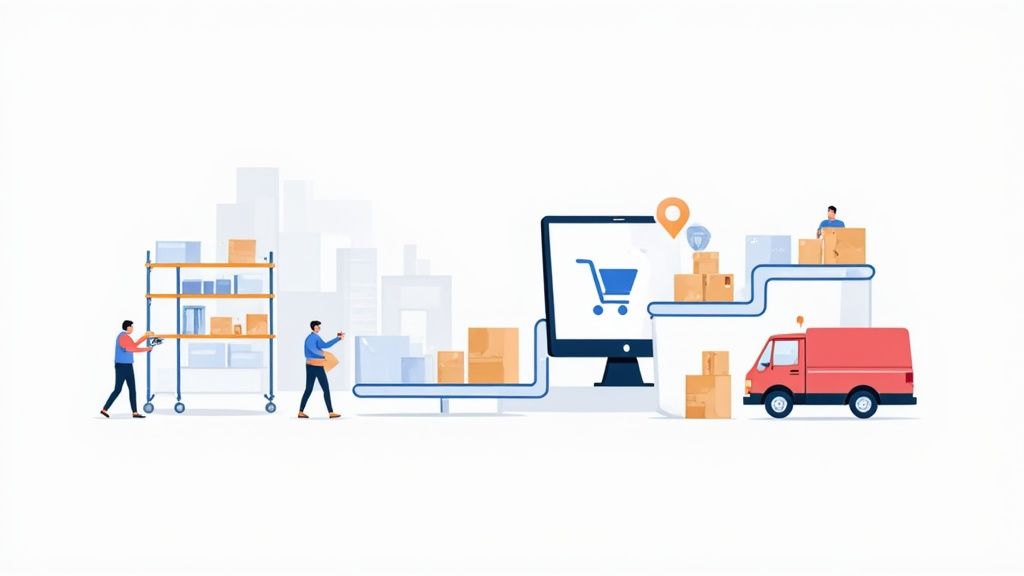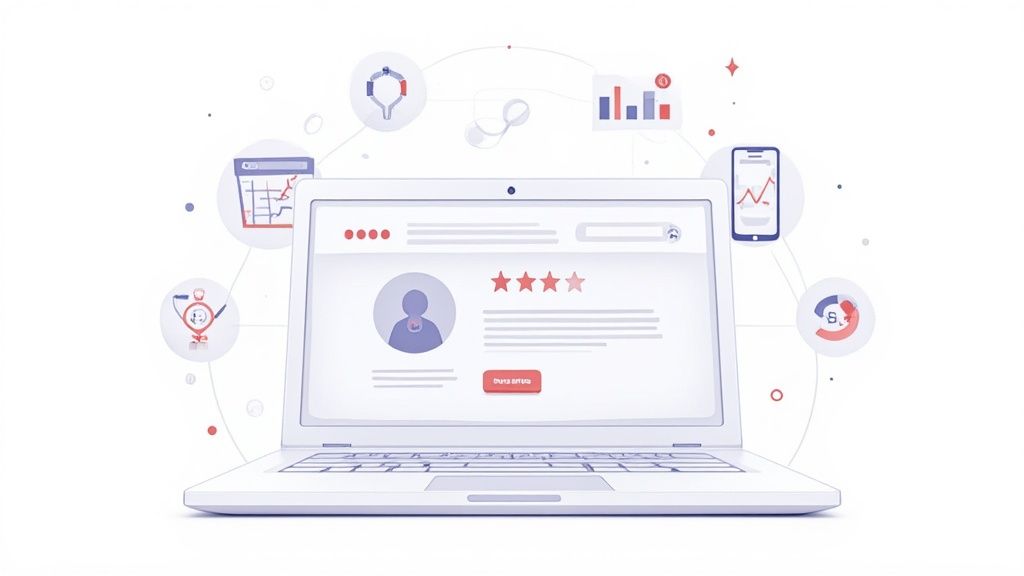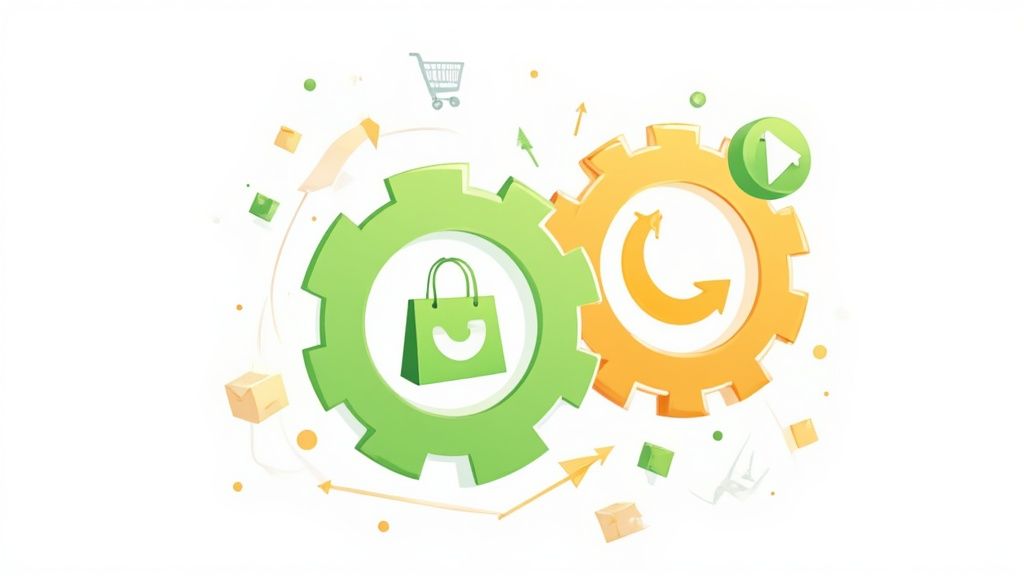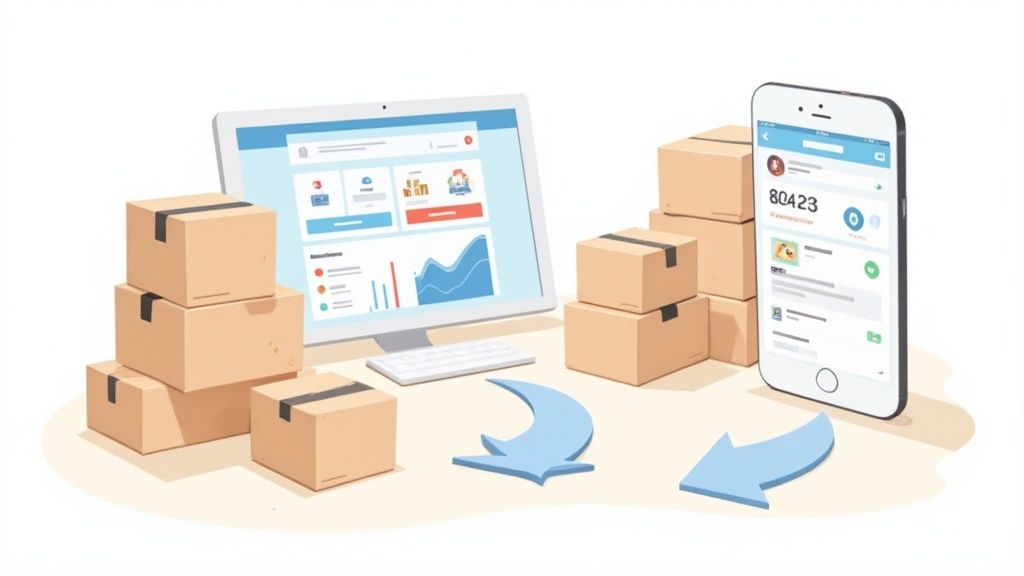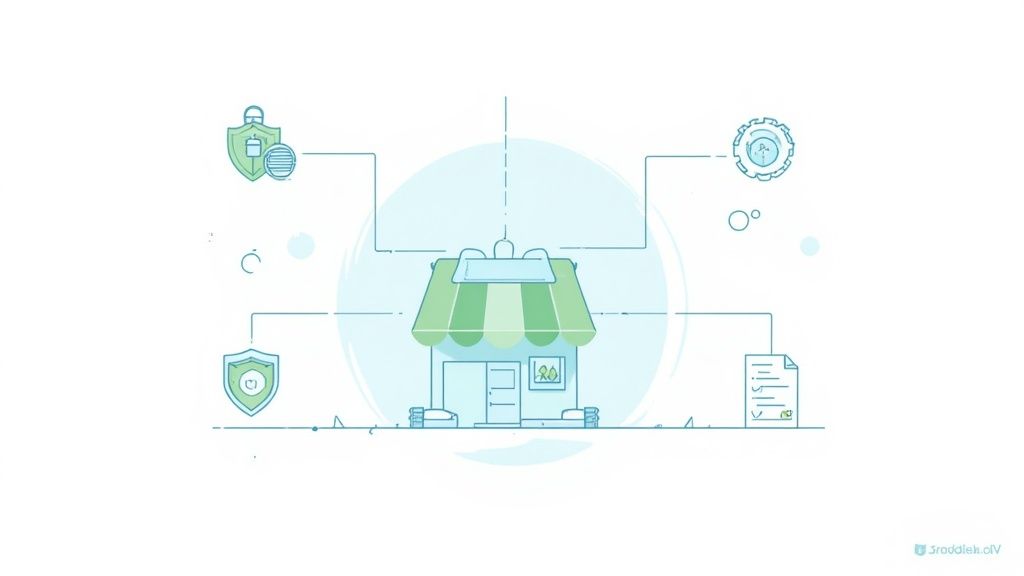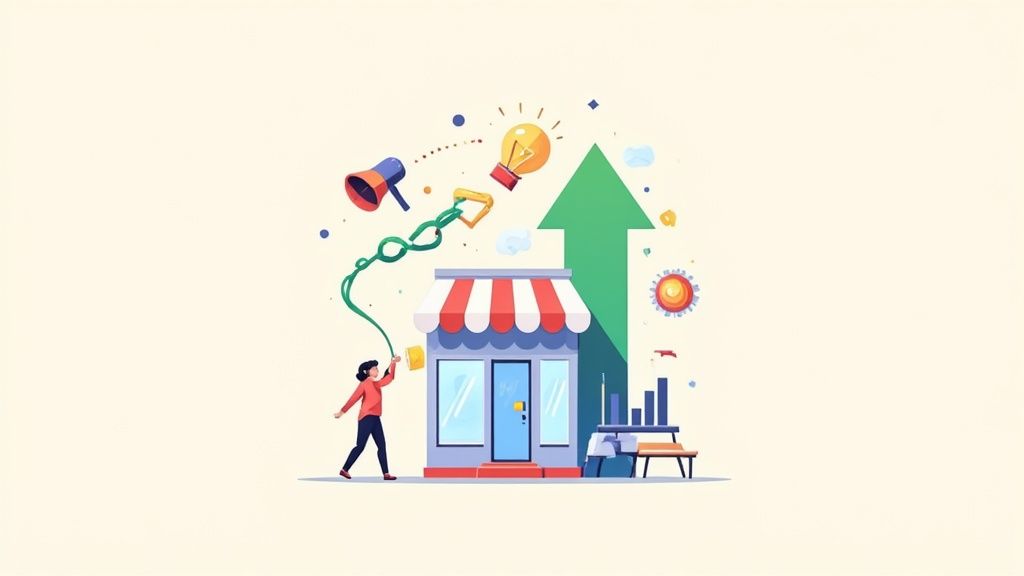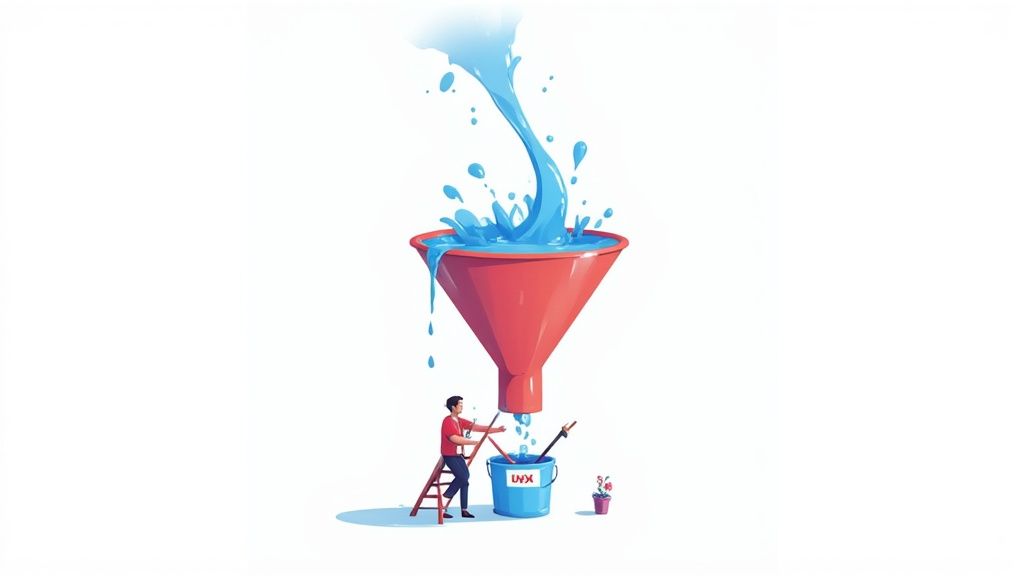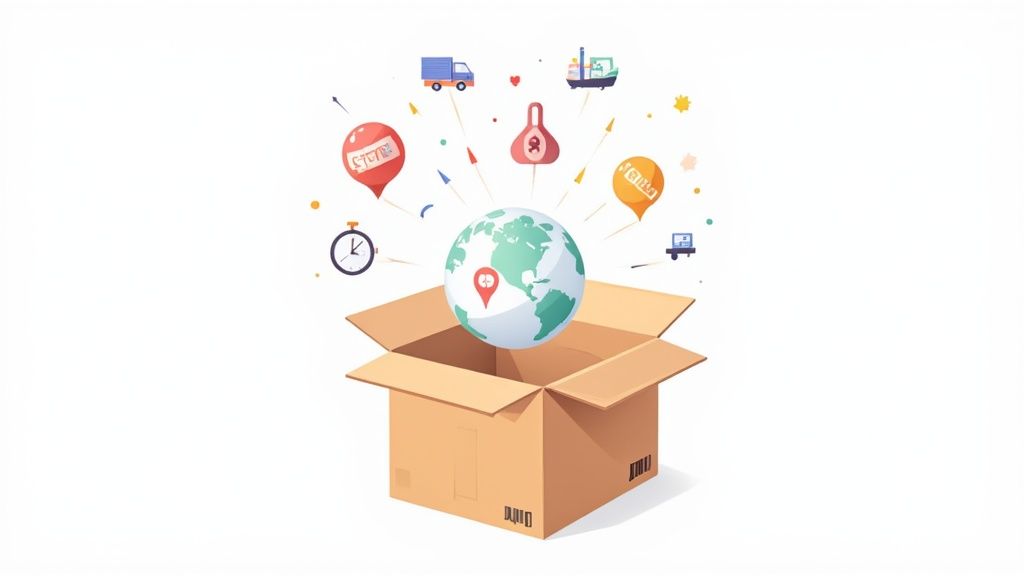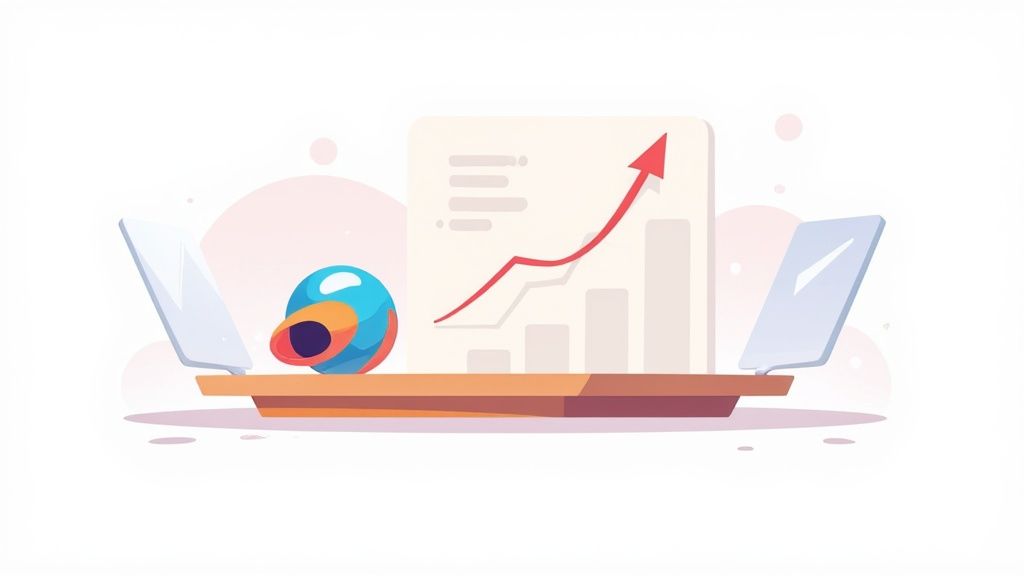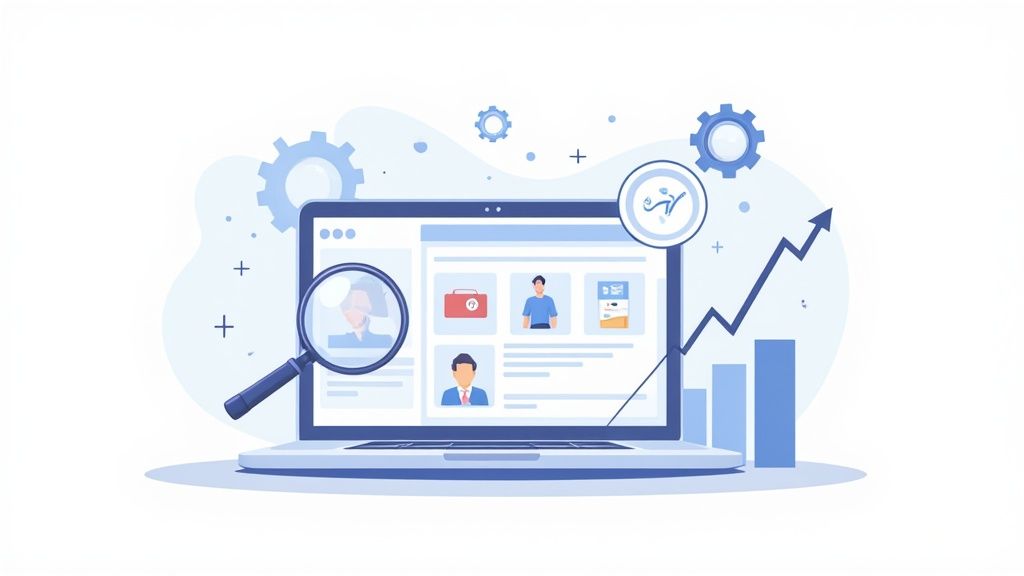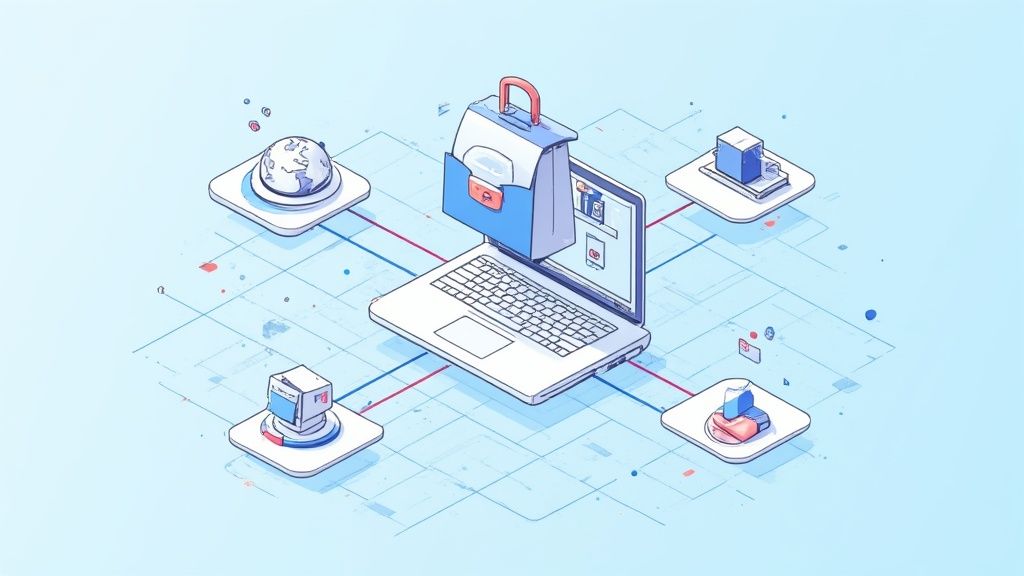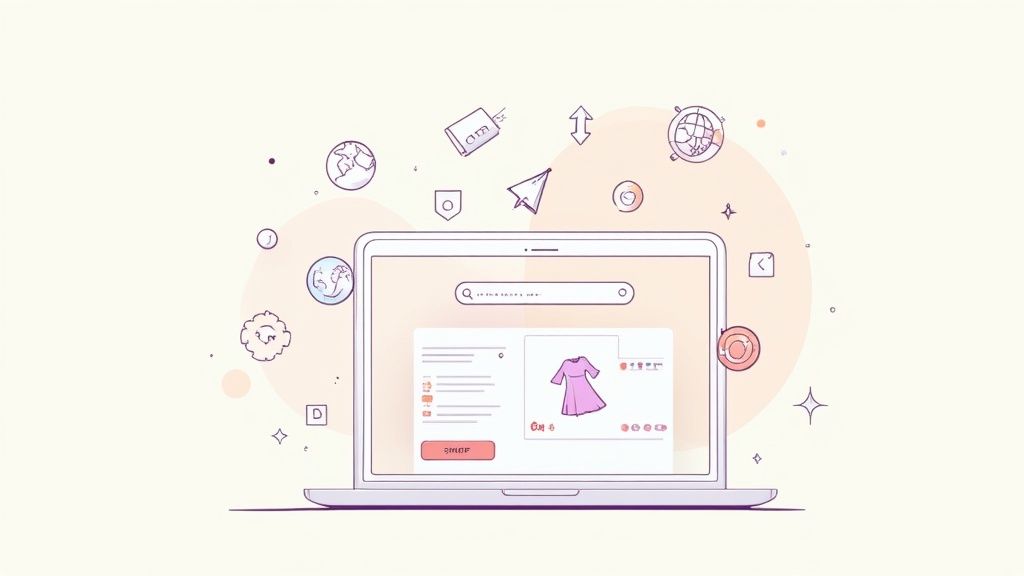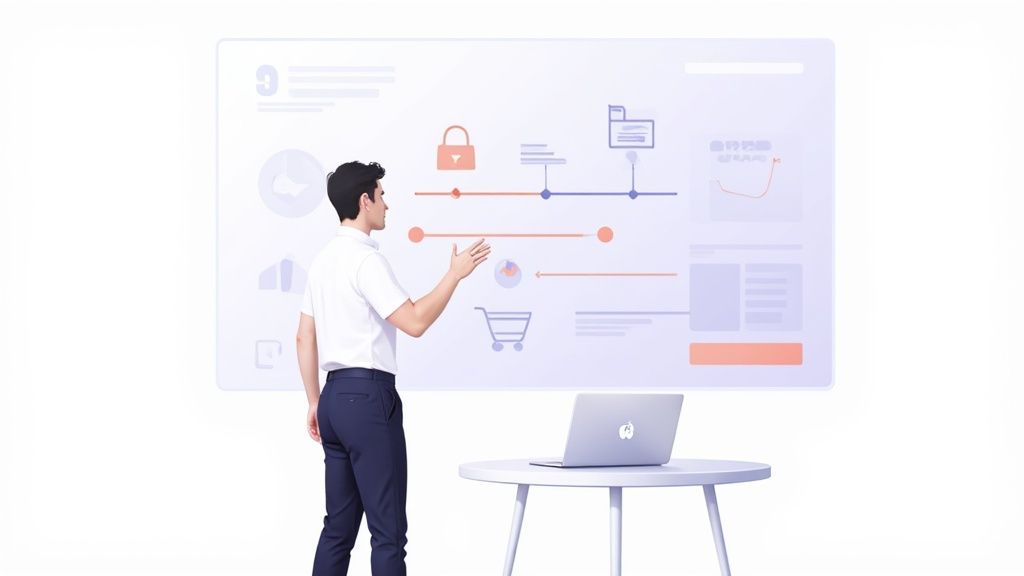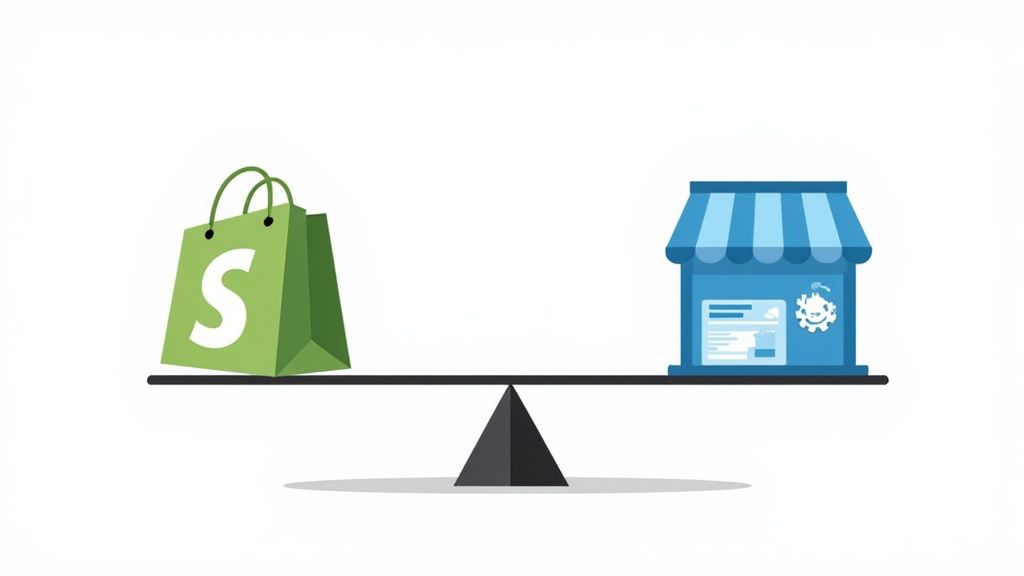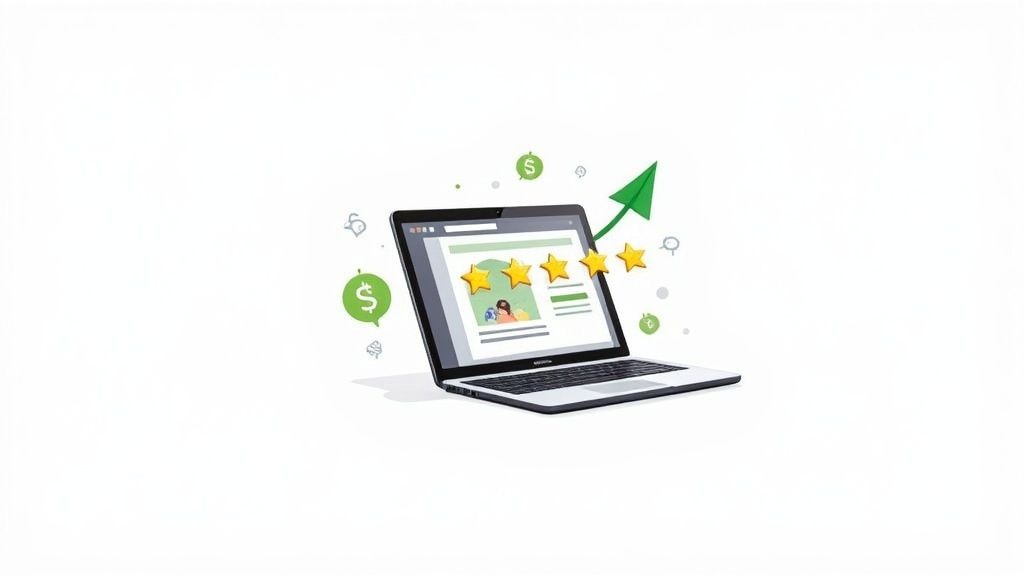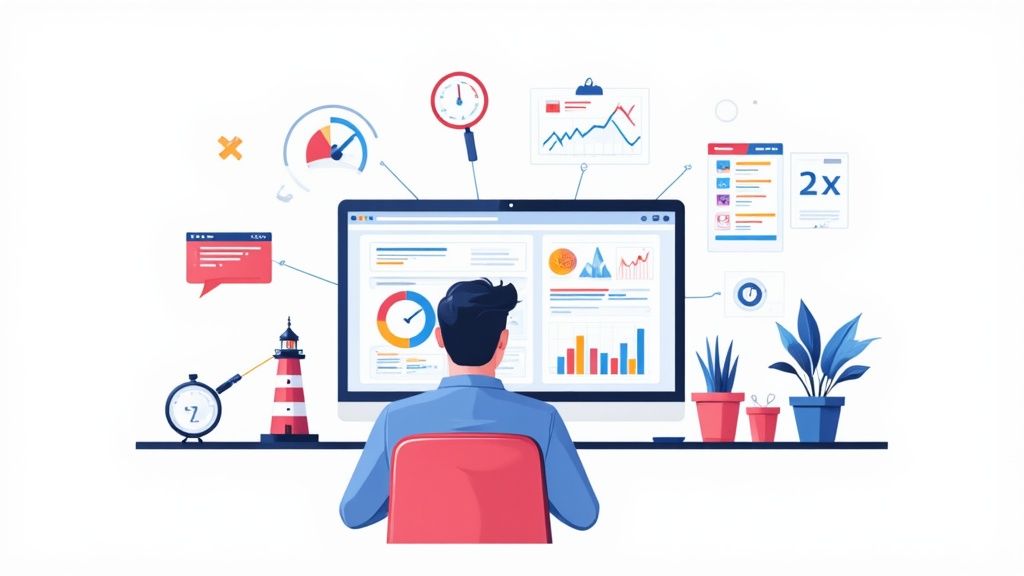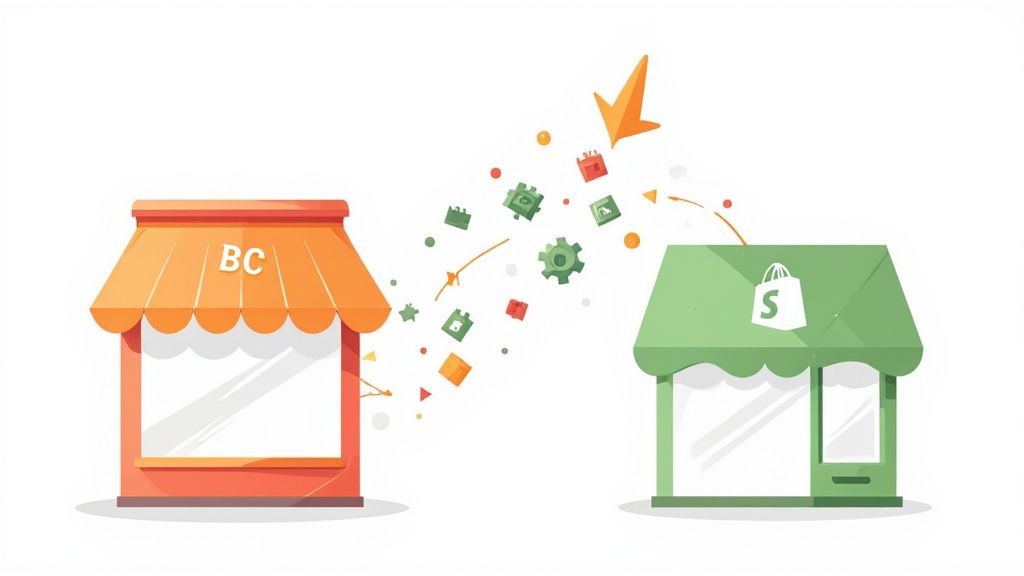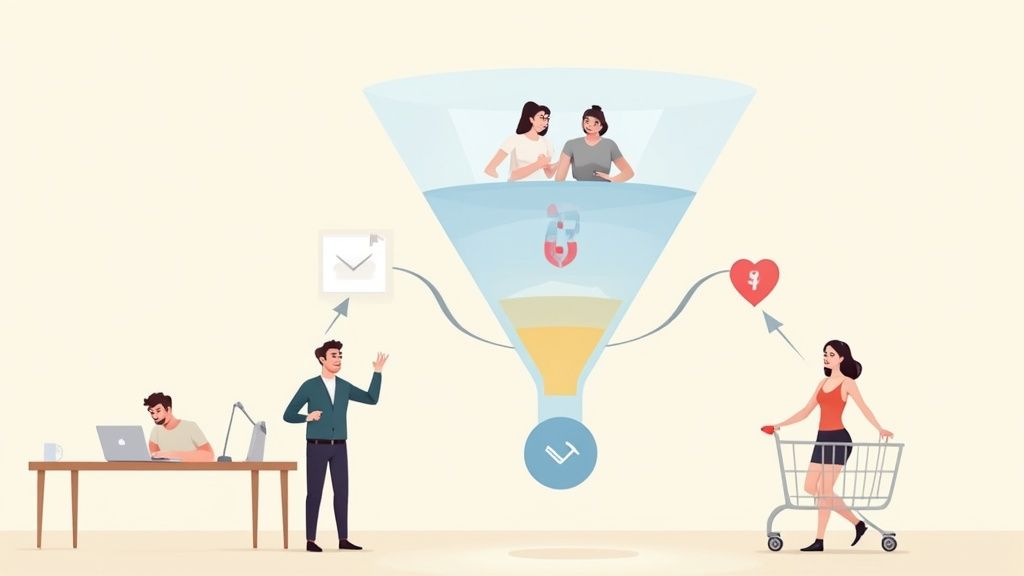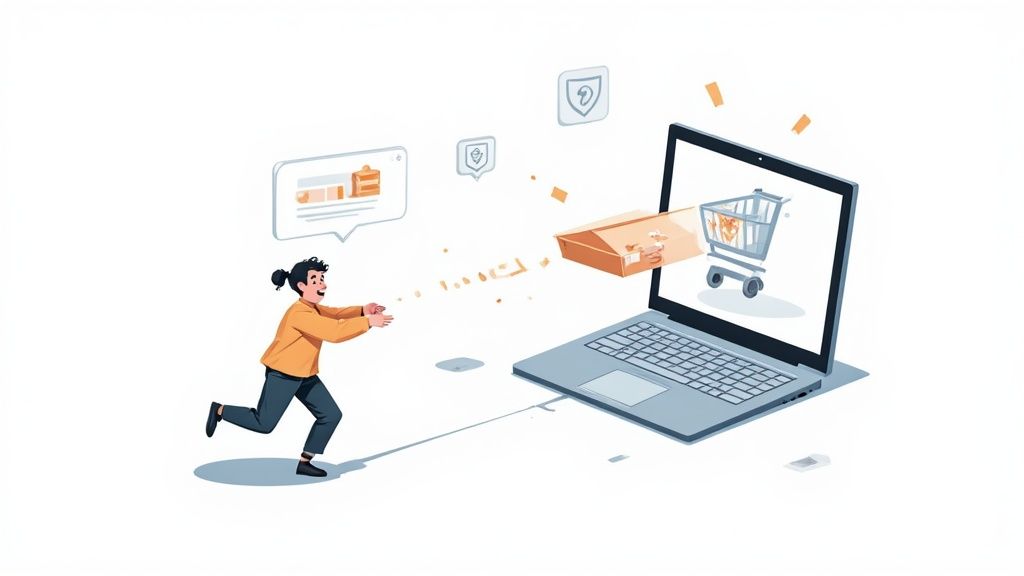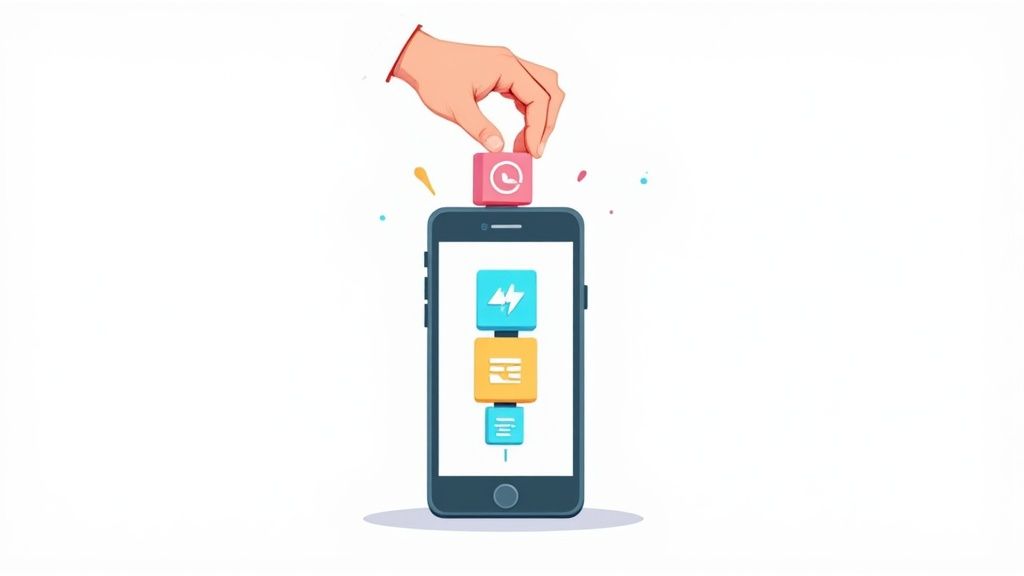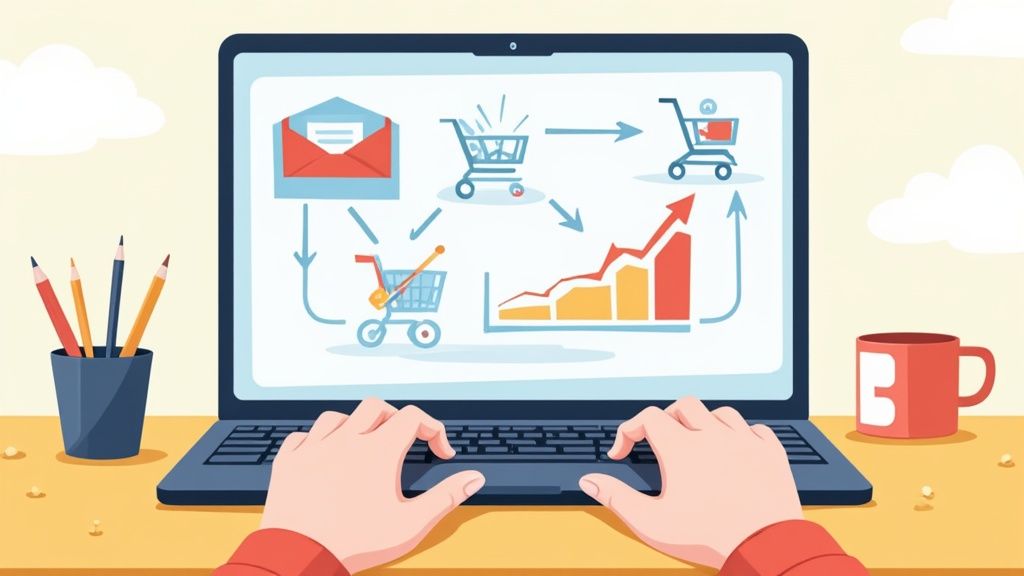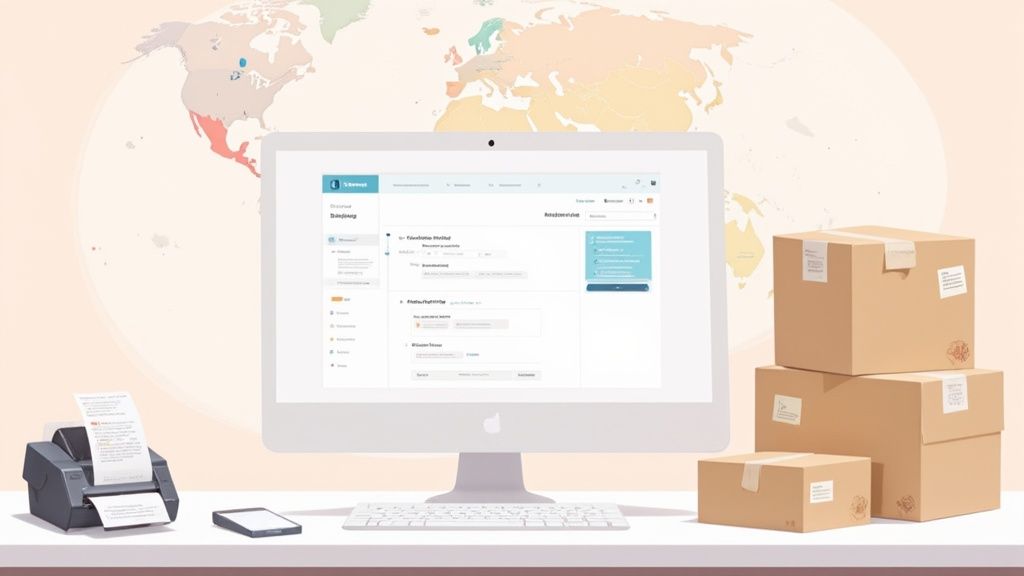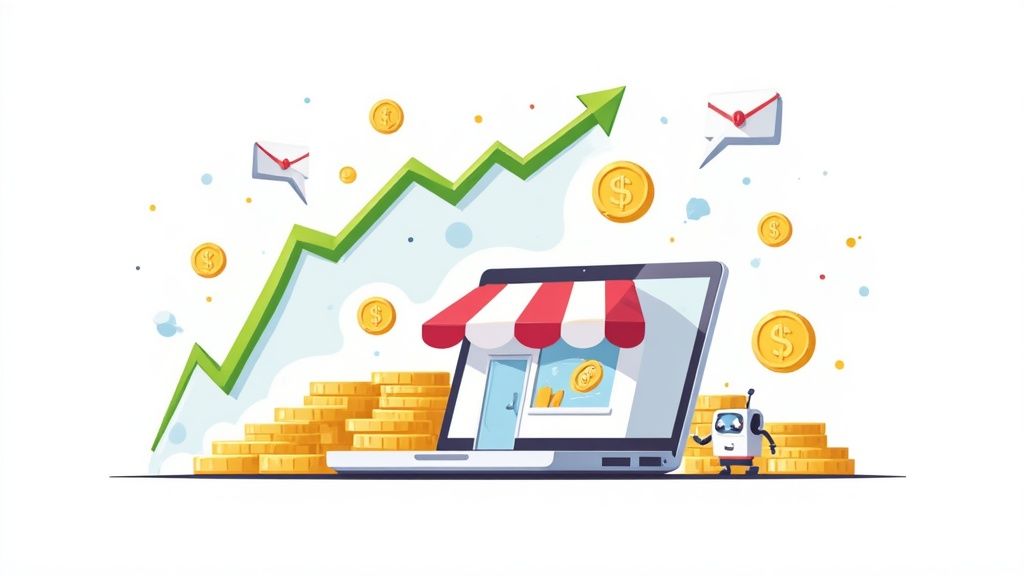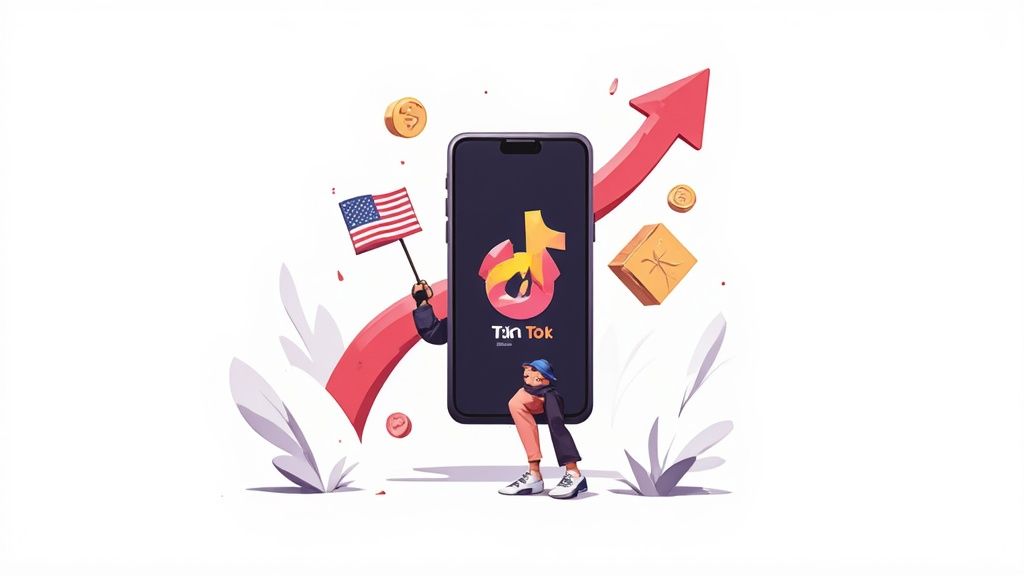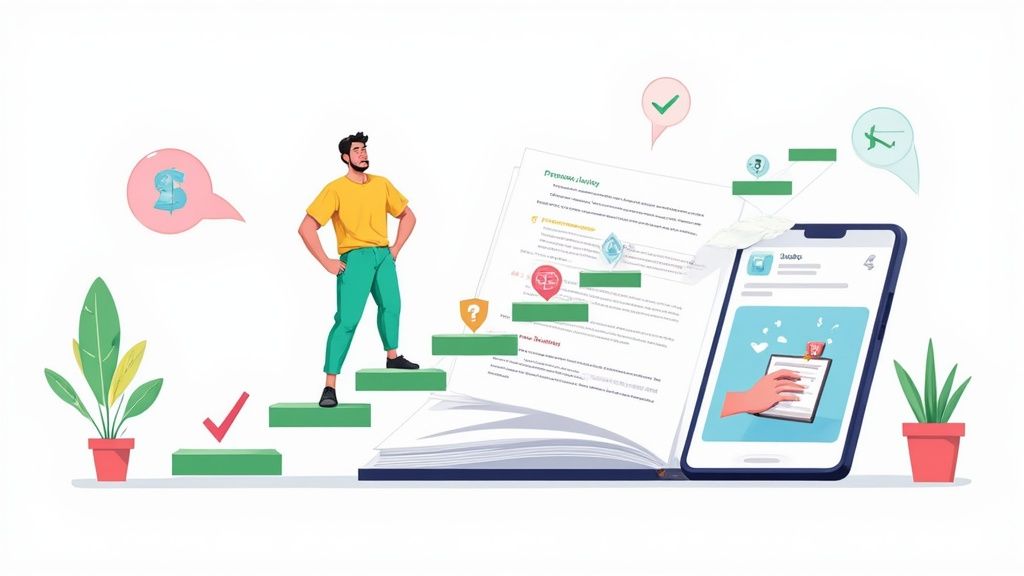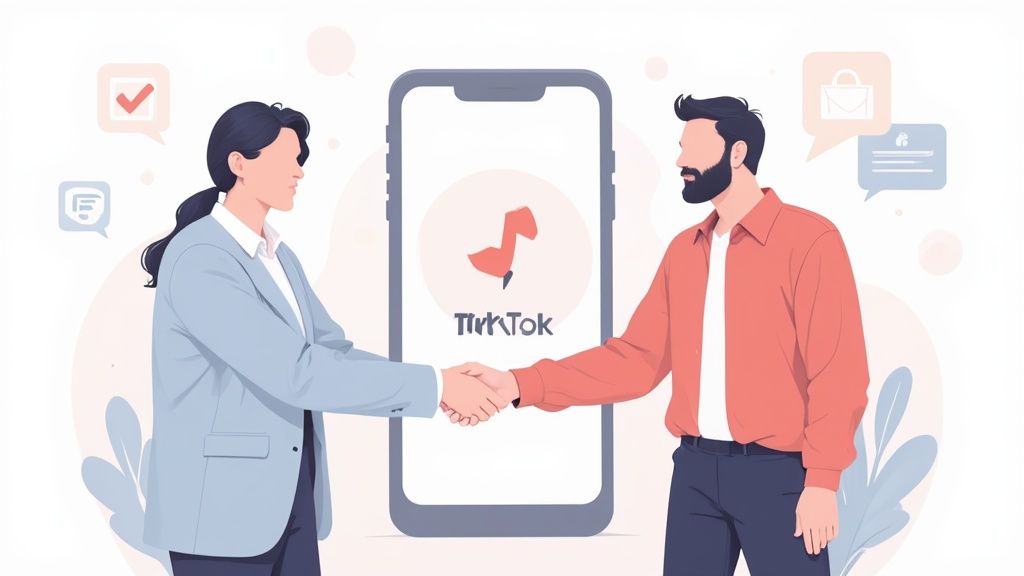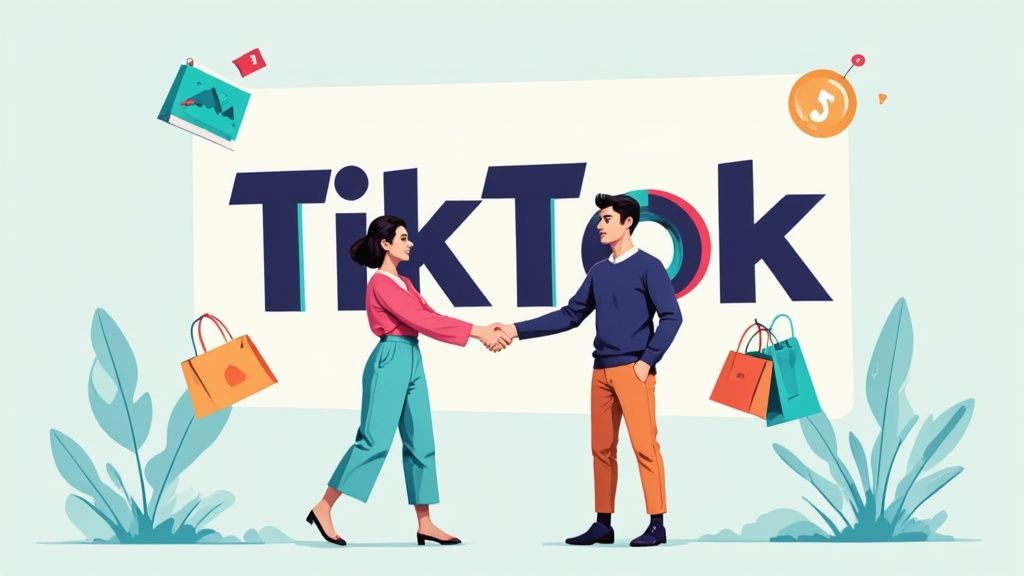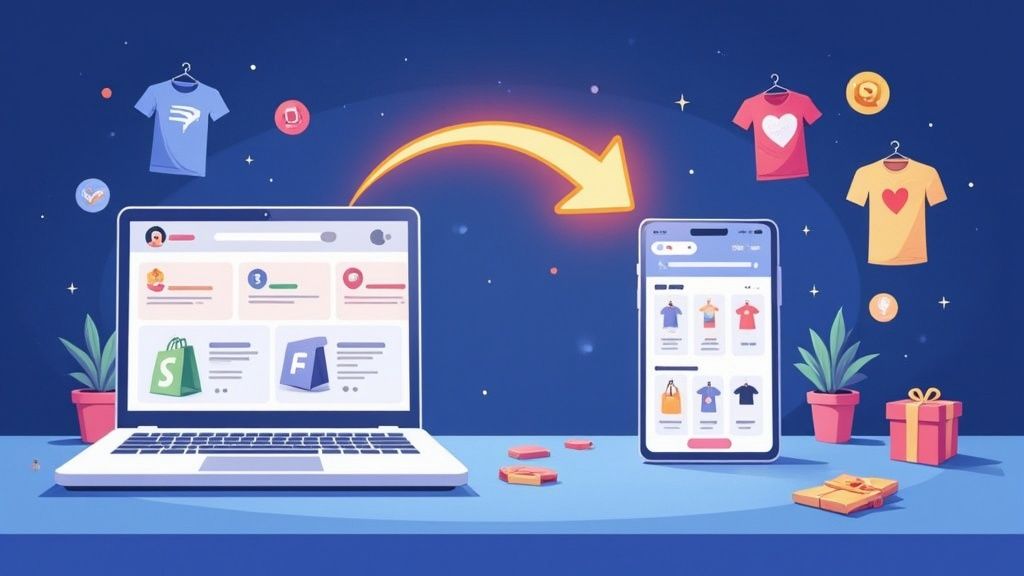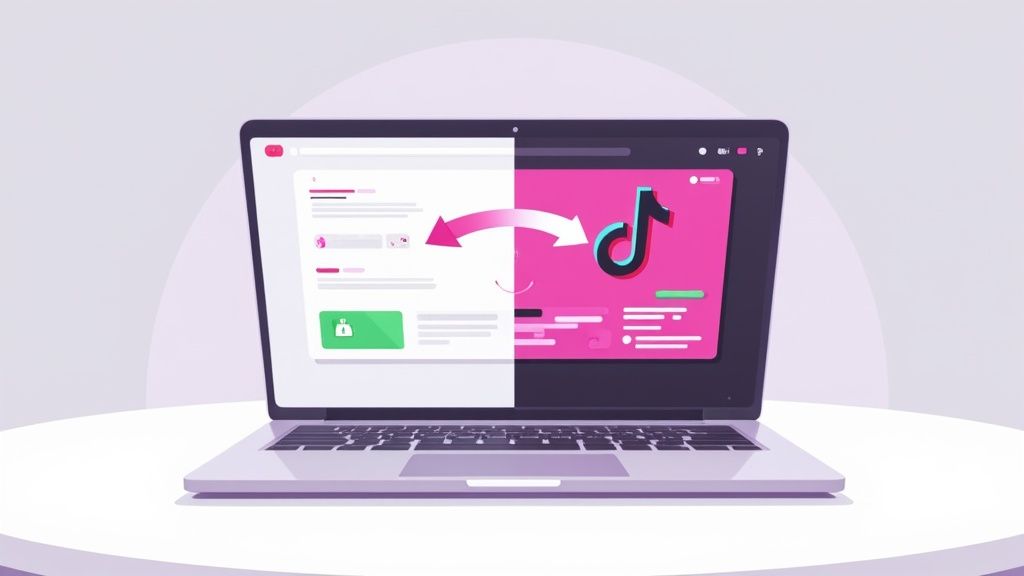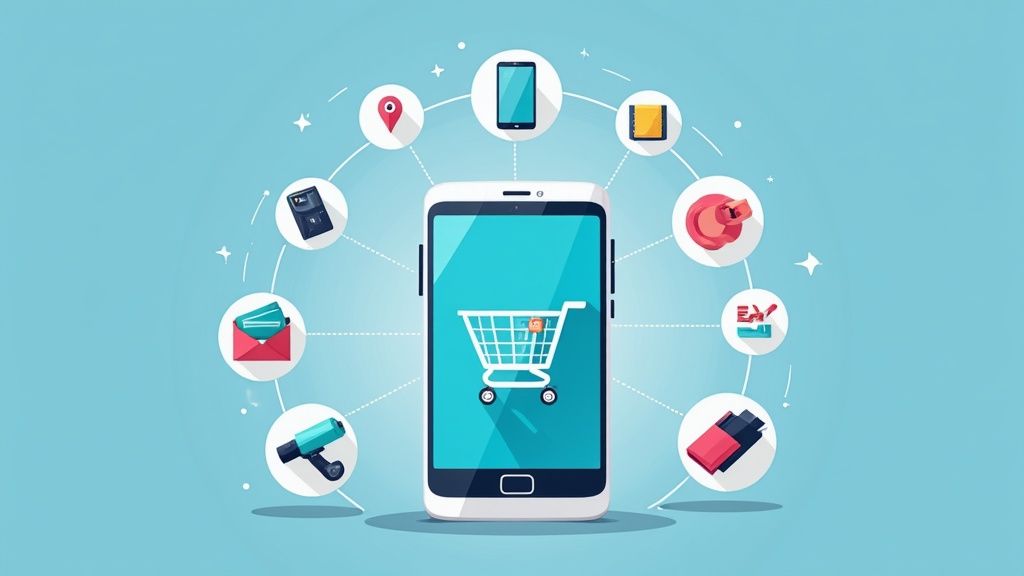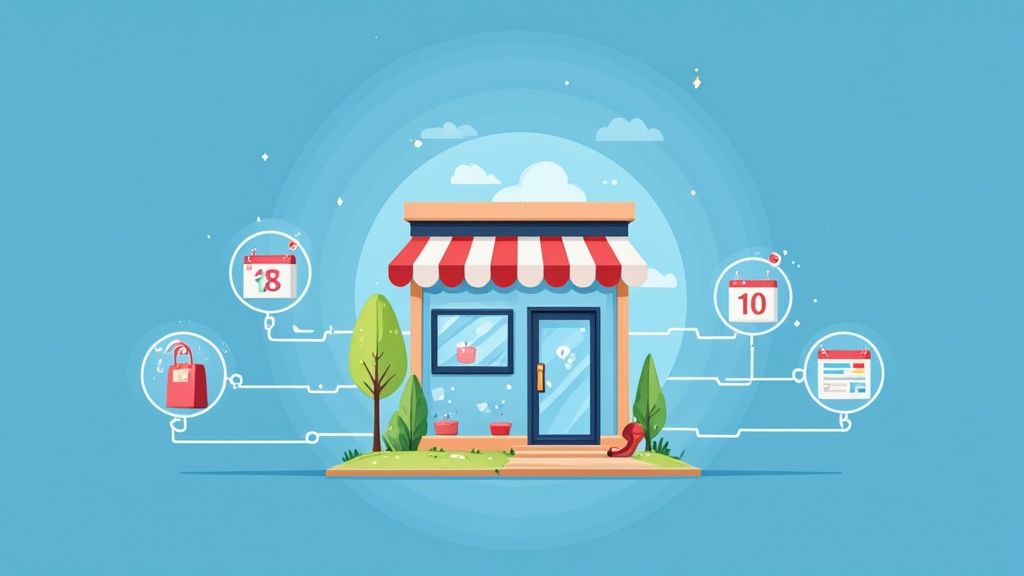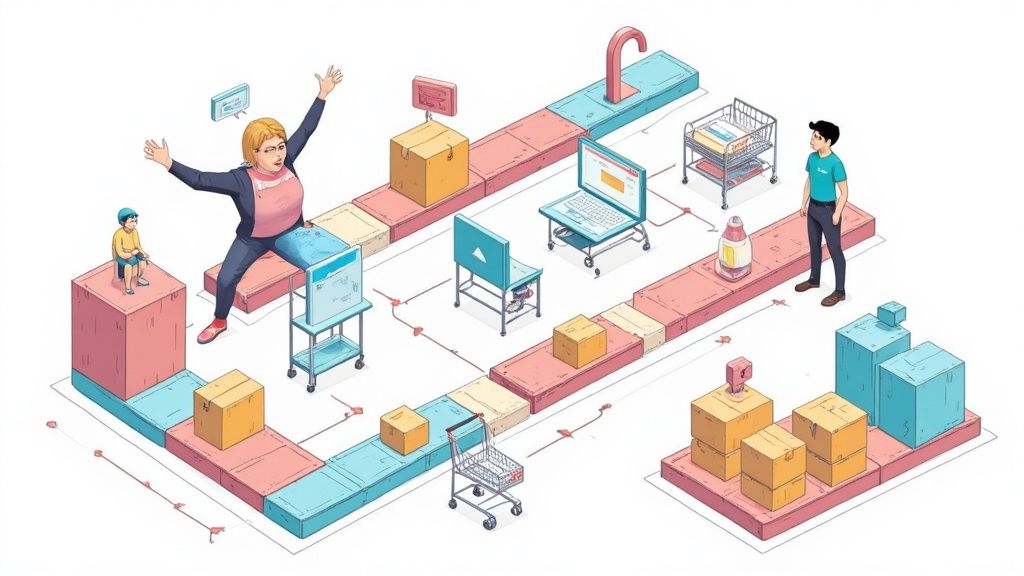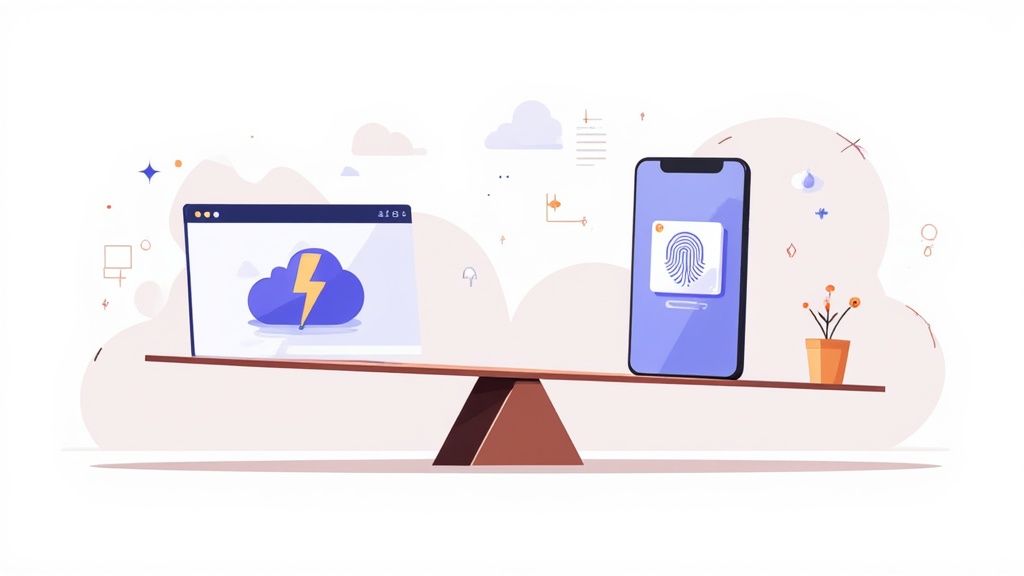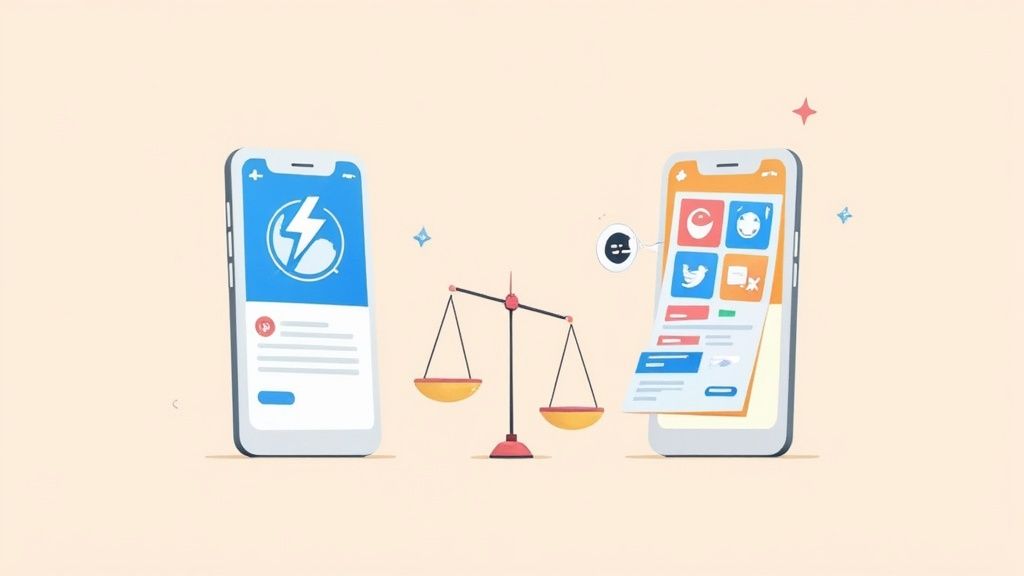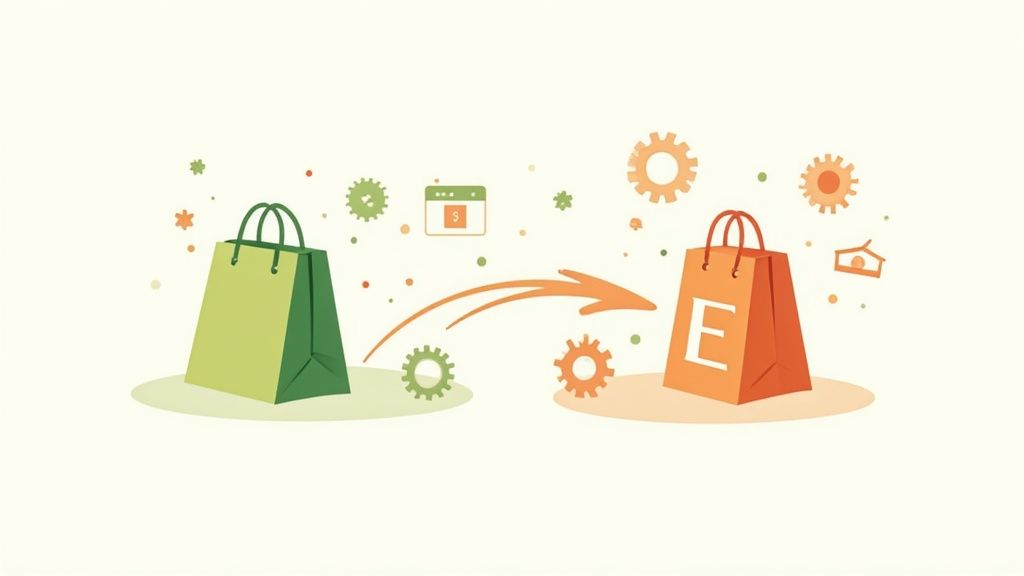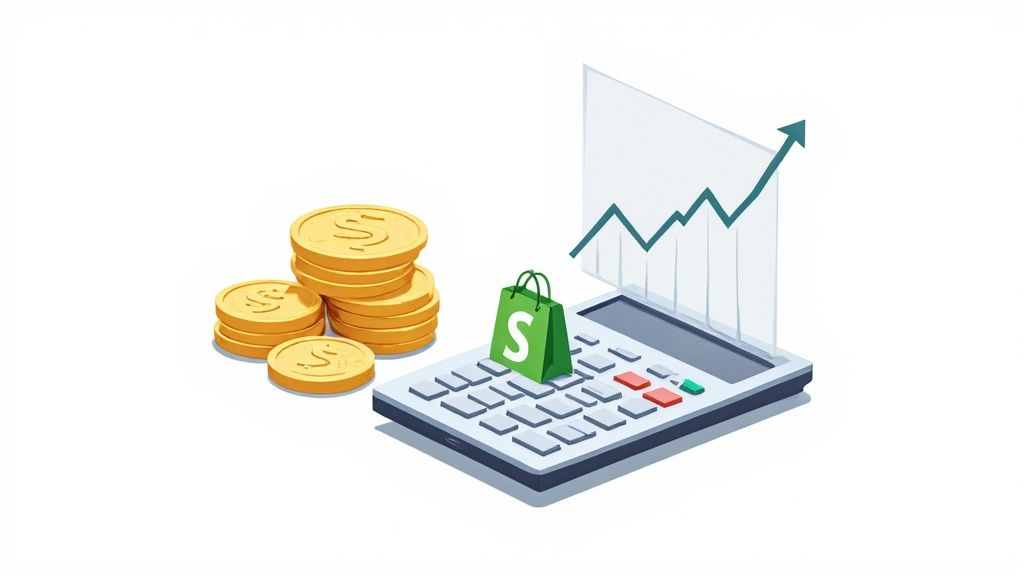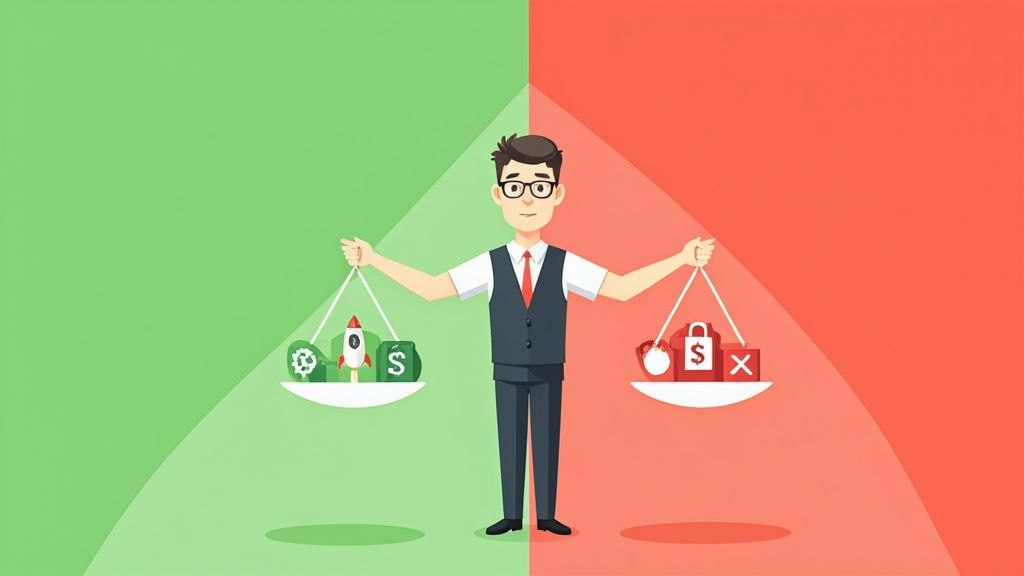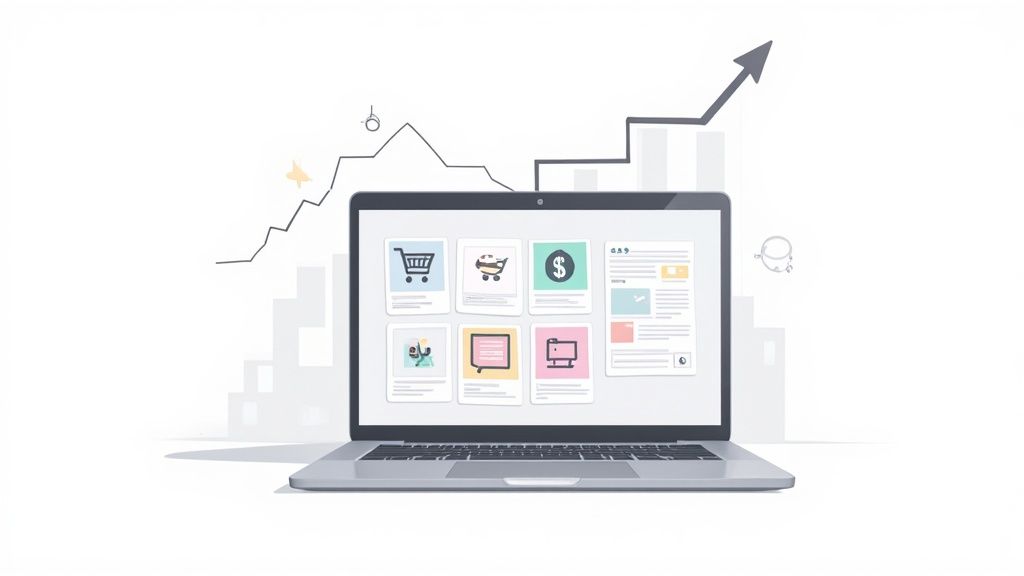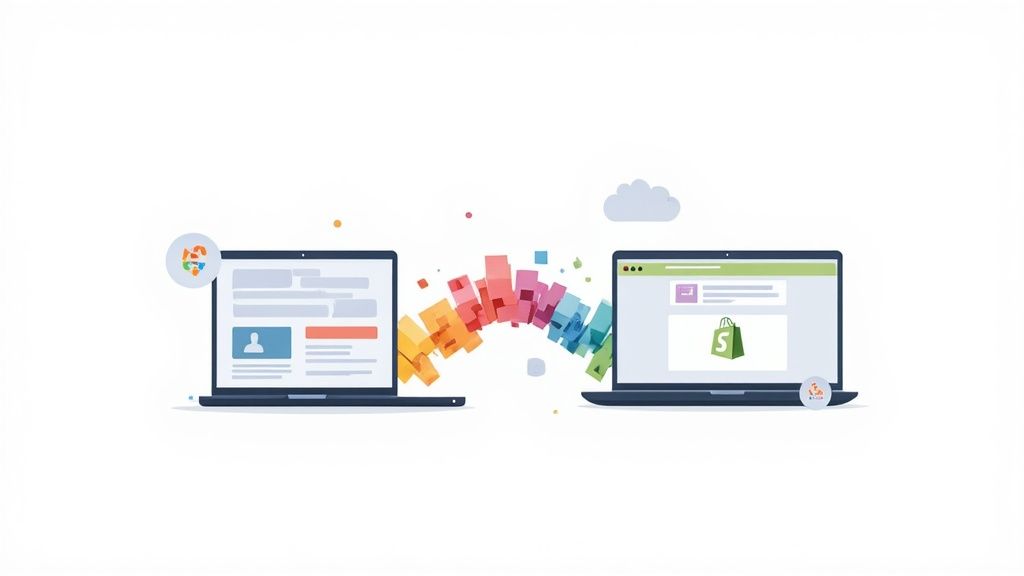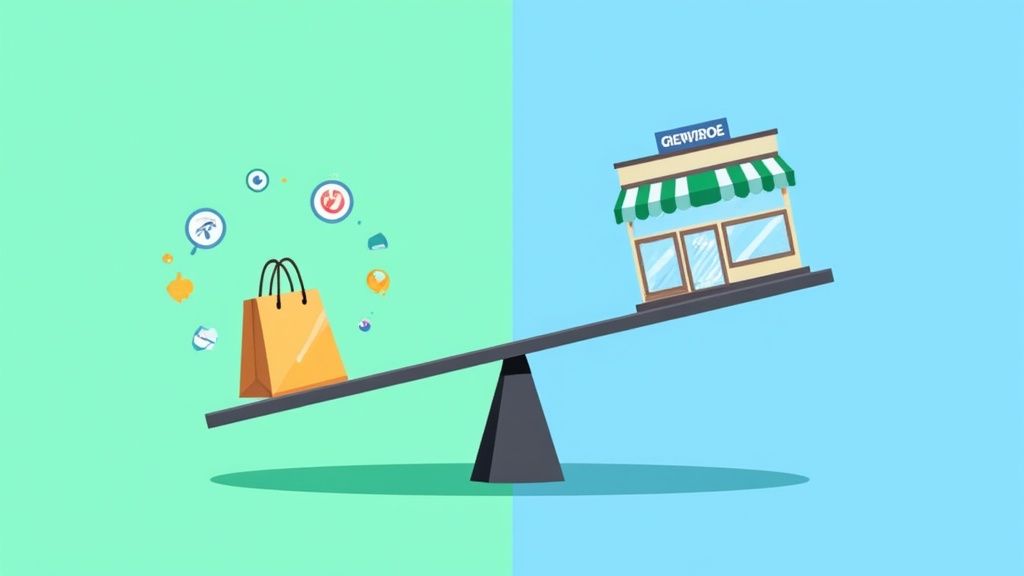
The choice between BigCommerce or Shopify really boils down to one fundamental question: Do you want powerful features baked right in, or do you prefer a simple, clean core that you can build on with apps?
Think of it this way: BigCommerce gives you more advanced tools straight out of the box. Shopify, on the other hand, keeps its core platform incredibly user-friendly and relies on its massive app store for anything beyond the essentials. The right answer for you depends entirely on whether you value an all-in-one system or an endlessly flexible, app-driven one.
Choosing Your E-commerce Foundation
Picking between BigCommerce and Shopify is one of the first—and most important—decisions you'll make as an online entrepreneur. This guide isn't about listing features side-by-side; it's about giving you a framework to decide based on your business model, your growth plans, and how comfortable you are with technology.
We'll start with the core philosophies driving each platform. Shopify is famous for its ease of use, making it a go-to for startups and direct-to-consumer brands. BigCommerce packs a heavier punch with built-in features, especially for B2B sellers.
Instead of looking for a "best" platform, the goal is to find the one whose architecture just fits your vision. It's also smart to think ahead and consider how your choice will handle future growth and new sales channels, like integrating with critical social media trends, including social commerce. Getting this right from the start saves you from a massive headache and costly migration down the road.
Quick Look BigCommerce vs Shopify at a Glance
Before we dive deep, this table gives you a quick snapshot of the key differences. It's a great starting point to see which platform's approach resonates more with your immediate needs.
This table lays out the fundamental trade-offs. Now, let's explore what these differences mean in practice.
The screenshot below from Shopify’s homepage perfectly captures their brand message: making e-commerce accessible to everyone. It’s a huge part of their appeal.

This visual really drives home their focus on empowering entrepreneurs, which is central to their user experience.
The biggest differentiator isn't just the features themselves, but how you get them. Shopify’s app-first model offers incredible flexibility to build exactly what you need. BigCommerce’s built-in approach provides more stability and can mean lower long-term costs for stores with complex needs.
This decision impacts everything from your day-to-day workflow to your long-term ability to scale. While both platforms are leaders in the space, they cater to very different business needs and growth paths.
For a wider perspective, take a look at our complete e-commerce platform comparison to see how these two stack up against the rest of the market. Now, let’s get into the details.
Understanding Market Share and Platform Maturity
When you’re weighing BigCommerce against Shopify, the sheer scale of each platform is a huge piece of the puzzle. Market share isn't just a number to brag about; it has real-world consequences for the third-party apps available, the size of the developer community, and how easily you can find help online.
Shopify is, without a doubt, the heavyweight champion here. Its massive global footprint means you’re plugging into a deeply mature and well-oiled ecosystem from the moment you sign up. For anyone just starting, this is a massive leg up, guaranteeing a huge menu of themes, apps, and developers ready to go.
Shopify's Dominant Market Position
To get a sense of Shopify's scale, it controls about 10.32% of the entire global ecommerce platform market. But zoom in on the United States, and its grip is even tighter, commanding an impressive 29% of the market. Globally, Shopify is the engine behind roughly 4.8 million active online stores, and a staggering 3 million of those are right here in the U.S. You can dig deeper into Shopify's extensive market presence on redstagfulfillment.com.
What does all this mean for you as a store owner? A few things:
- A Bigger Talent Pool: Finding someone who really knows Shopify—whether a developer, designer, or marketer—is just plain easier and often cheaper. There are simply more pros who specialize in it.
- More Innovative Apps: A larger user base is a magnet for app developers. This fuels a constant flow of new tools and integrations that can add powerful new features to your store.
- Tons of Community Support: If you hit a snag, help is everywhere. Official forums, Facebook groups, YouTube tutorials—the volume of community-driven support for Shopify is immense.
BigCommerce's Strategic Niche
While Shopify wins on sheer numbers, BigCommerce has cleverly carved out its own powerful territory. It’s a serious contender, and while its overall market share is smaller, its influence is concentrated and growing, especially with mid-market and B2B companies.
BigCommerce powers tens of thousands of stores worldwide, but its real strength is attracting merchants who need more complex features baked right in from the start. We’re talking about businesses with huge product catalogs, multiple international sales channels, or wholesale operations that can truly benefit from BigCommerce’s robust native functionality.
This isn't just about picking the biggest platform on the playground. It’s about finding an ecosystem that mirrors your business model. Shopify's massive community is perfect for D2C brands that crave flexibility, while BigCommerce's focused user base offers a rock-solid foundation for complex B2B and enterprise needs.
This difference in market focus is everything. If you're a new brand aiming to launch fast with tons of app options, Shopify's mature ecosystem is the obvious choice. But if you're an established business with tricky operational needs, BigCommerce’s strategic growth in the mid-market space makes it an equally smart bet. Understanding that context is the key to figuring out which platform will actually support your long-term ambitions.
Comparing Built-in Features vs App Dependency
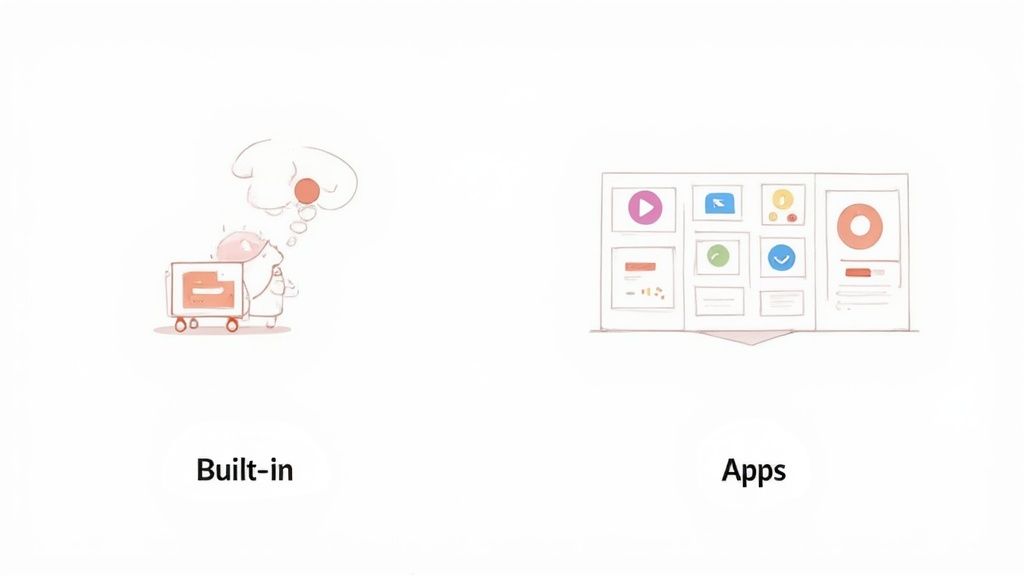
The real debate between BigCommerce or Shopify isn't about who has more features. It's about how those features get to you. This fundamental difference in philosophy shapes everything—your daily workflow, your monthly bills, and how complex your store becomes. Think of it as choosing between an all-inclusive resort and a build-your-own-adventure trip.
BigCommerce goes for the "all-inclusive" route. Its core selling point is a massive suite of advanced tools baked right into the platform. From day one, you get access to powerful functionality without having to hunt down and install a single third-party app.
BigCommerce: The All-In-One Powerhouse
With BigCommerce, many of the features you'd pay extra for elsewhere are standard. This approach really simplifies store management and makes your costs more predictable, which is a huge plus for businesses that know they need advanced capabilities right out of the gate.
Here are a few core functions built directly into BigCommerce:
- No Transaction Fees: BigCommerce charges 0% transaction fees across all its plans, no matter which payment gateway you use. That's a big deal if you want the freedom to use Stripe or PayPal without getting dinged by extra platform fees.
- Advanced Product Options: It offers a much more granular system for product variants and custom fields out of the box. This is a lifesaver for stores selling complex or highly customizable products.
- Real-Time Shipping Quotes: This is included on every plan, so you can show customers accurate, live shipping costs from major carriers.
- Multi-Currency Selling: Native support for selling in different currencies is a massive advantage for any brand looking to build an international customer base.
This screenshot from the BigCommerce homepage really drives home its focus on enterprise-ready features built for growth.

The messaging is clearly aimed at established businesses searching for a powerful, scalable engine for their online sales. For these merchants, having critical tools integrated from the start means less complexity and fewer headaches from apps clashing with each other.
The biggest win with BigCommerce's model is stability and lower long-term costs for feature-heavy stores. When your key functions are native, you spend less time worrying about app updates and compatibility, freeing you up to focus on growing your business.
While it might not have Shopify’s sheer market share, BigCommerce holds its own by sticking to this feature-rich strategy. The platform has a solid 2.5% conversion rate and an average order value of $137, proving it works well for merchants who truly need its native toolset.
Shopify: The App-Centric Ecosystem
Shopify takes the complete opposite path. It gives you a sleek, incredibly intuitive core platform and then lets you customize it to your heart's content through its world-class App Store. The model is all about flexibility and ease of use, allowing you to build a store that's perfectly tailored to your needs.
The thinking is simple: you only pay for what you actually use. A brand-new startup doesn't need a dashboard cluttered with features it won't touch for years. Instead, they can start lean and bolt on new functionality as they scale.
When you're weighing the feature sets, looking at things like Shopify's crypto payment capabilities highlights the difference. BigCommerce focuses on traditional gateways, whereas Shopify's app ecosystem lets merchants quickly jump on emerging payment methods.
This reliance on apps has its own set of pros and cons.
Advantages of Shopify's Model:
- Unmatched Flexibility: With over 10,000 apps available, you can find a solution for pretty much any business need, from loyalty programs to sophisticated analytics.
- Simplicity for Beginners: The core platform is way less intimidating, which makes it much easier for new entrepreneurs to get a store up and running quickly.
- Constant Innovation: The competitive app marketplace means developers are always releasing new and improved tools.
Potential Downsides:
- Rising Costs: Those monthly subscription fees for multiple paid apps can add up fast. In some cases, you could end up paying more than you would for a higher-tier BigCommerce plan.
- App Overload: Juggling dozens of apps can become a real chore. Each one needs to be updated and checked for compatibility, which can sometimes slow down your site or cause conflicts.
- "Death by a Thousand Subscriptions": It's surprisingly easy to lose track of all the recurring app fees, making it tough to forecast your monthly expenses with any real accuracy.
Ultimately, deciding between BigCommerce's built-in power and Shopify's app-driven flexibility comes down to what your business needs right now and how comfortable you are with the technical side of things.
Analyzing True Cost and Long-Term Value

When you're comparing BigCommerce or Shopify, just looking at the monthly plan price is a rookie mistake. It’s like buying a car without asking about insurance or gas mileage. The real story is in the total cost of ownership (TCO)—everything from the cut they take on each sale to what you'll shell out for apps down the road.
At first glance, their pricing tiers look pretty similar. Both get you in the door for around the same monthly fee. But dig a little deeper, and you’ll find two completely different philosophies on fees that can drastically change your bottom line as you start to scale.
Decoding Transaction and Processing Fees
The first and most immediate cost you'll run into is transaction fees. This isn't just a minor detail; it’s a percentage that comes directly out of your profit on every single order.
Shopify really, really wants you to use its own payment gateway, Shopify Payments. If you play by their rules and use it, they won't charge you any extra transaction fees. But if you want to use an outside processor like PayPal or Stripe, they'll hit you with an additional fee on top of what the processor charges. This fee ranges from 2% on the Basic plan down to 0.5% on Advanced.
BigCommerce takes the opposite approach. They charge zero transaction fees on every single one of their plans. Period. It doesn’t matter which payment gateway you use. This freedom lets you shop around and find the absolute best credit card processing rates for your business without getting dinged by the platform itself.
Shopify Payments is a fantastic, all-in-one starting point for new businesses that simplifies everything. For bigger brands, however, the ability to negotiate better rates with a third-party processor on BigCommerce could lead to massive long-term savings.
This isn’t just about the percentages. It's a strategic choice that defines how you manage your payments and operational overhead from day one.
The Hidden Costs of Apps and Upgrades
Once you get past transaction fees, the next big variable is how much you'll rely on apps. Shopify's ecosystem is built around its massive App Store. While many apps are free, the ones that add serious power—think loyalty programs, subscriptions, or advanced reporting—almost always have their own monthly fees. It's easy to find your monthly bill creeping up by hundreds of dollars.
BigCommerce packs more of this advanced functionality into its core platform right out of the box. This generally leads to a much more predictable monthly cost, which is a big part of their pitch to businesses that know they'll need sophisticated features from the get-go.
But BigCommerce has its own cost trigger to watch out for. Their plans are directly tied to your annual online sales. When your revenue crosses a certain threshold, you're automatically bumped up to the next, more expensive plan.
Here's a quick look at how these costs play out in different scenarios:
Ultimately, figuring out the true cost requires a bit of forecasting. A small D2C brand launching its first product will probably find Shopify's straightforward, integrated setup more affordable at the start. On the other hand, a high-volume B2B operation could save thousands on BigCommerce by dodging transaction fees, making the risk of a forced plan upgrade a smart trade-off. It all comes down to your business model.
Can It Keep Up With Your Growth? Performance and Scalability
For any ambitious brand, the real question isn't just "which platform works now?" It's "which one can handle our business when it explodes?" You need an engine that won't sputter out when you're going viral or hitting record Black Friday numbers.
Both BigCommerce and Shopify are built to handle serious traffic, but they approach high-volume operations from different angles. It's less about which is "faster" and more about how their architecture supports your specific kind of growth.
Shopify’s infrastructure is a beast. It's been battle-tested by millions of stores, simultaneously handling massive traffic spikes from celebrity product drops and global sales events without breaking a sweat. It’s a testament to its raw power and reliability.
BigCommerce Enterprise also delivers stellar performance, but its edge often lies in its powerful built-in features and more generous API limits. This is a huge deal for businesses with complex catalogs or deep integrations.
When You Go Enterprise: Plus vs. Enterprise
Once your revenue climbs and your needs get more complex, you graduate from the standard plans. The real showdown is between Shopify Plus and BigCommerce Enterprise. This is where their core philosophies really diverge.
Shopify Plus is practically engineered for the modern, high-growth DTC brand. Its headless commerce tools, like Hydrogen and Oxygen, give developers the keys to the kingdom. They can build completely custom, lightning-fast storefronts and shopping experiences that live anywhere—websites, mobile apps, you name it.
BigCommerce Enterprise, on the other hand, is the undisputed champion for complex B2B and wholesale operations. It comes loaded with native B2B features right out of the box—things like customer-specific pricing, bulk order portals, and quote management. You get all this without needing a bunch of expensive apps or custom code.
Think of it this way: If your growth strategy is all about brand and building unique, content-driven customer experiences, Shopify Plus gives you a more flexible canvas. If your growth is tied to managing sophisticated B2B sales channels, BigCommerce Enterprise is the more streamlined, ready-to-go solution.
API Limits and Technical Headroom
As you scale, your store needs to talk to other systems—your ERP, CRM, warehouse software, and more. This communication happens through API calls, and hitting your limit can bring operations to a grinding halt.
Historically, BigCommerce has been known for its higher API call limits on enterprise plans. This makes it a rock-solid choice for businesses that need to sync massive amounts of data constantly, like inventory levels from multiple warehouses or complex customer data from a CRM.
Shopify Plus has definitely closed the gap on API limits over the years, but for certain high-volume operations with intense data-syncing needs, BigCommerce still offers a bit more breathing room. It’s a small technical detail that can have a massive impact on your day-to-day efficiency.
Let's Look at Two Scenarios
To make this tangible, imagine two different businesses on a growth trajectory:
- The Global Fashion Brand: Their goal is to create immersive, content-rich shopping experiences for customers worldwide. They need headless capabilities to design a unique front-end completely separate from their back-end commerce engine. For this brand, Shopify Plus is the clear winner.
- The B2B Parts Supplier: This company sells specialized industrial equipment to other businesses. They need to handle complex catalogs, customer-specific pricing tiers, purchase orders, and a self-service wholesale portal. BigCommerce Enterprise was built for exactly this.
The market share numbers also tell a story. Shopify's ecosystem is vast, holding 29% of the U.S. market, while BigCommerce is closer to 3%. This isn't just about popularity; it shows that Shopify’s model appeals to a broader range of high-growth D2C brands. As you can see from a deeper dive into these market share dynamics on chargeflow.io, while both platforms can scale, Shopify's ecosystem simply attracts a larger critical mass of growing merchants.
Making Your Final Decision: A Scenario-Based Guide
Alright, let's get down to brass tacks. Choosing between BigCommerce and Shopify isn't about picking a universal "winner." It's about finding the right tool for your specific job. This is where we move past feature lists and get into clear, scenario-based advice to help you see which platform aligns with your business model, your comfort with tech, and where you plan to go next.
At its core, the difference is simple but profound. Shopify gives you a beautifully streamlined foundation that you customize and expand using apps. Think of it as a sleek, modern apartment where you bring in your own furniture. BigCommerce, on the other hand, is more like a fully-furnished house—it’s more complex upfront but comes packed with powerful, built-in features right out of the box.
For Startups and D2C Brands
If you're launching a startup, you're a creator, or you're a direct-to-consumer brand focused on getting to market fast with a killer design, Shopify is the clear frontrunner. Its dashboard is famously intuitive, and the massive theme marketplace lets you build a store that looks pro in days, not weeks. The whole setup process is designed to be as painless as possible, so you don't need a developer on speed dial.
Shopify's app ecosystem is your secret weapon here. You can launch lean and mean, then bolt on functionality like loyalty programs or subscription boxes as your business grows and you figure out what your customers really want.
For a new business, speed to market and simplicity are everything. Shopify gets the tech out of your way so you can pour your energy into your product, your brand, and making those first critical sales. It’s built to empower entrepreneurs, not overwhelm them.
For B2B and Complex Retailers
Now, if you're an established retailer with a massive or complicated product catalog, big international ambitions, or a serious B2B sales operation, BigCommerce offers a much more robust, all-in-one solution. Crucial features like multi-currency selling, advanced product filtering, and customer group pricing are built right in, meaning you're far less reliant on a patchwork of third-party apps.
This integrated approach gives you stability and more predictable costs, especially when you know you'll need those sophisticated tools from day one. You won’t be juggling multiple app subscriptions or chasing down compatibility headaches.
This infographic breaks down how your primary growth focus—D2C or B2B—can steer your decision.
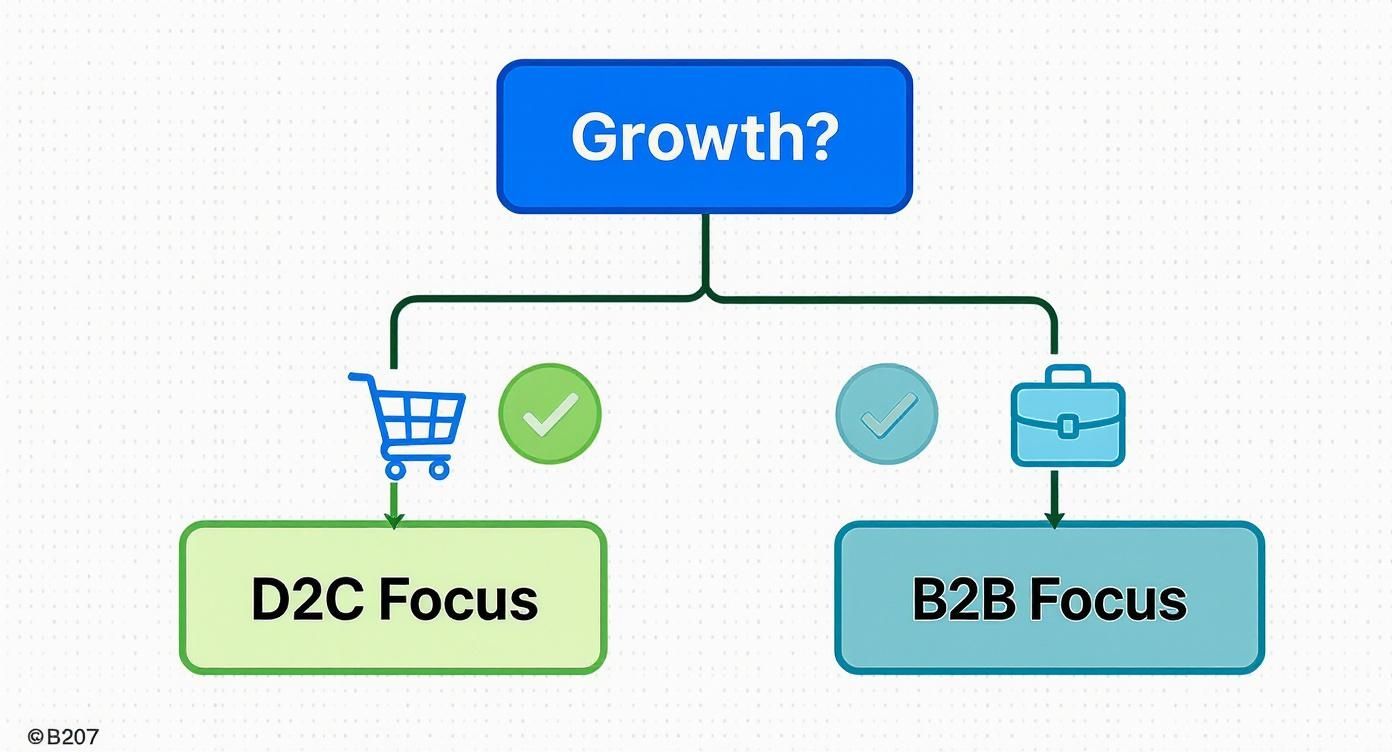
As you can see, the decision tree really highlights Shopify's agility for D2C brands, while BigCommerce's native architecture is built to handle the heavy-duty structural needs of B2B commerce.
Making the Right Choice for Tomorrow
The platform you choose today directly impacts how easily you can scale tomorrow. If your current setup is starting to feel like a straightjacket, a platform migration might be on the horizon. To get a sense of what that looks like, you can read our guide on how to migrate from BigCommerce to Shopify. Sometimes, making that strategic leap is what it takes to unlock your next phase of growth.
Ultimately, the best choice comes down to a clear-eyed look at what you truly need.
- Choose Shopify if: Your priority is speed, ease of use, and building a powerful D2C brand with a flexible, app-powered toolkit.
- Choose BigCommerce if: You're managing a complex inventory, have a significant B2B component, or want powerful features built-in from the start without app overload.
By matching the platform’s philosophy to your business’s reality, you can choose with confidence and build your store on a foundation that’s truly set up for success.
Frequently Asked Questions
When you're weighing BigCommerce against Shopify, the decision usually boils down to a handful of specific questions. Let's cut through the noise and get you direct answers to the most common queries we hear from merchants.
Is Shopify Really Cheaper Than BigCommerce?
On the surface, their monthly plans look pretty similar. But the real cost? That depends entirely on how you run your business.
For a brand-new store, Shopify can definitely feel cheaper. If you stick with Shopify Payments (which lets you dodge their extra transaction fees) and don’t go wild with paid apps, it’s a very cost-effective way to get started.
On the other hand, BigCommerce often pulls ahead for more established or complex businesses. The big draw is its 0% transaction fee promise on all plans, regardless of your payment processor. Plus, so many features are built-in that you’ll likely spend a lot less on third-party apps, and those savings add up fast as you scale.
Which Platform Has Better SEO Features?
Both platforms are powerhouses for SEO and nail the fundamentals—customizable URLs, meta tags, image alt text, you name it. For a long time, BigCommerce had a reputation for a slight edge, with more granular controls right out of the box, like automatically generating a robots.txt file.
But Shopify has pretty much closed that gap. Its massive App Store is packed with specialized SEO tools that can easily match, and sometimes even beat, what BigCommerce offers natively. Honestly, your SEO success will hinge more on your strategy than on which of these two platforms you choose.
Can I Migrate From One Platform to The Other?
Absolutely. Moving between BigCommerce and Shopify is something businesses do all the time, but don't underestimate the work involved. It’s a major project that demands careful planning.
Transferring all your products, customer data, and order history is complex. While plenty of tools and migration services can automate a lot of the heavy lifting, you’ll likely need some technical help to make sure everything goes smoothly. The last thing you want is to lose your hard-earned SEO rankings or create a clunky experience for your customers.
Key Takeaway: Migrating is a big deal. It’s always best to pick the right platform from the get-go, but if you outgrow your first choice, making the switch is totally achievable with the right support.
Which Is Better for A Small Business?
For most small businesses, especially those just launching, Shopify is generally the better choice. It’s incredibly approachable.
The user-friendly dashboard, quick setup, and huge library of themes mean you can get a beautiful store live without needing a developer. The model of starting lean and adding features through apps as you grow is a perfect fit for a new venture finding its groove. BigCommerce is fantastic, but its huge built-in feature set can sometimes be overwhelming for a simple store just getting off the ground.
Ready to build a store that not only looks great but is engineered for growth? At ECORN, we specialize in Shopify development and conversion rate optimization to help brands scale effectively. Explore our services and see how we can elevate your e-commerce project.








